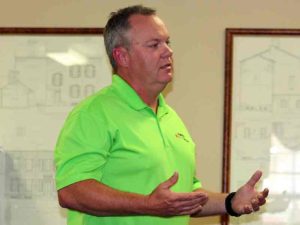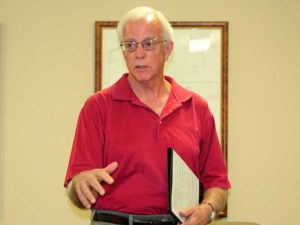City council upholds HRB’s denial of vinyl siding in city’s historic district

Councilman Francis Lydian examines a handout provided by Derek Hutchins that shows other examples of existing vinyl siding in the city’s historic district. The council upheld the Historic Review Board’s decision to not allow Hutchins to use vinyl siding at the rear of the building he owns at 114. North Third St. The council voted to uphold the HRB’s decision with Lydian abstaining.
By JIM BROOKS
Nelson County Gazette / WBRT Radio
Wednesday, July 13, 2016, 2 p.m. — If you own property in Bardstown’s historic district, don’t count on using vinyl siding in an area visible from the street.

Derek Hutchins explains why he believes he should be allowed to replace existing vinyl siding with a better quality vinyl siding product at the rear of the building he’s renovating at 114 North Third St. Hutchins provided photos of existing buildings in the historic district that have vinyl siding in place.
In a special hearing Tuesday night, the Bardstown City Council upheld the Historic Review Board’s denial of an application to replace existing vinyl siding used at the rear of 114 North Third St., the old Mammy’s Kitchen building. The denial was based on the HRB’s guidelines that prohibit the use of vinyl siding in applications plainly visible from a publicly maintained street or alley.
Property owner Derek Hutchins owns the building and has been renovating it. Hehad asked the HRB to allow him to replace existing vinyl siding at the rear of the building with a better quality insulated vinyl siding. The HRB denied his application based on the historic district’s guidelines, and Hutchins appealed their decision to the council.
Despite the HRB’s prohibition of vinyl siding, Hutchins pointed out several instances where vinyl siding is in place on homes elsewhere in the historic district and is very visible.
The siding Hutchins wants to add would replace some existing older vinyl and will cover concrete block. The HRB suggested an alternative material — a cement board product — but Hutchins said the cost of using it was about 30 percent higher than the vinyl he wanted to use. Painting the block is an option, but would require more maintenance.
GUIDELINES TIGHTENED. RaShae Jennings, the city’s historic preservation coordinator, told the council that existing vinyl siding in the historic district was either installed prior to changes in the district’s guidelines, or installed without HRB approval.
“You cannot look around the historic district and go by what you see,” Jennings explained.
The district’s guidelines are based on national preservation standards and were first adopted in 2008 and updated in 2012. The guidelines state vinyl siding is not an appropriate material in areas visible from a publicly maintained street or alley.

Preservation Coordinator RaShae Jennings listens to council questions regarding the HRB’s guidelines at Tuesday’s hearing regarding an appeal of the board’s decision to deny the use of vinyl siding in the historic district.
Based on the guidelines, the HRB is simply not willing to approve vinyl siding in the historic district for new construction, she explained.
Hutchins’ plans for the rear of the building include an outdoor dining area, which will make the rear of the building a more visible, she said.
Bardstown Mayor John Royalty questioned the board’s recommendation of a more expensive material that looks essentially the same as the vinyl siding.
The HRB does not take cost into consideration on its decisions on applications, Jennings said. The board’s focus is on what’s best for the structure and maintaining its historic integrity.
Councilman Bill Buckman said if vinyl isn’t allowed on new construction then it should be required to be removed from buildings in the district where it is now installed.
“There should be a mechanism in place to deal with these buildings that are in the historic district and either change or give them a time frame to change,” he said.
HRB Chairman Pen Bogert told the council that the board has not approved replacing vinyl siding with vinyl siding or using it in new construction.
“This is not an anti-vinyl regulation,” he explained. “This is using vinyl on walls in areas that are clearly visible from a public way. If people want to use vinyl on a wall you can’t see, then why not?

HRB Chairman Pen Bogert told the council that the board’s guidelines allow the use of vinyl in areas not visible from a publicly maintained street or alley.
“It becomes clear when you use it that it is not anything approaching — visually or in standards of quality — a historic material,” he added.
The suggestion of cement board siding was not the only option available, just the one option the board recommended in its denial of Hutchins’ request.
“This is really about setting a precedent — and a potentially bad precedent — for the historic district,” he said. “What you’ve done is to open the floodgates for applications where you could use vinyl almost anywhere visible from a public street.”
Once the hearing was closed, the council deliberations made it clear that the council had little choice but to uphold the HRB’s decision.
“I don’t think its an arbitrary thing,” Councilman Fred Hagan said. “If we think we should allow vinyl then we should change the guidelines. If we’re going to maintain our classification as a historic district we have to uphold our guidelines.”
The council voted unanimously to uphold the HRB denial of Hutchins’ request with Councilman Francis Lydian abstaining.
-30-






